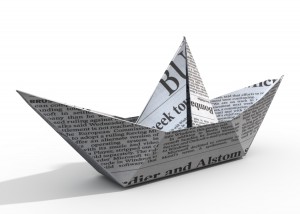10 видов заголовков в СМИ (и пара в Интернете)
В СМИ есть такие виды заголовков, как «шапка», рубрика, над- и подзаголовок, вводка, афишка, крик и др. В Интернете есть два основных вида заголовков, это «Title» и теги <Н1>-<Н6>.
Виды заголовков
Основной, главный заголовок
Самый распространенный тип, дает представление о содержимом материала. Может иметь такие формы, как вопрос, восклицание, обращение, утверждение, отрицание.
На страничке в Интернете это заголовок статьи, публикации и т.д., стоит между тегами <h1> и </h1>. Хорошо, если автоматом идет также в «Title» и плюсуется «Title» главной страницы. Например, <h1>Заголовки статей в СМИ и в Интернете</h1>; <title>Заголовки статей в СМИ и в Интернете.</title>
«Шапка»
 Применяется в подборках материалов, в тематических полосах, разворотах, номерах. Используется в виде призывов, приветствий, на 1 страницах, например, к празднику. Чаще находится выше названия газеты и всего текстового материала. Этим редакция подчеркивает важность события, выделяет его из массы других. «Шапки» обычно ставят вверху полосы, набирают крупным шрифтом.
Применяется в подборках материалов, в тематических полосах, разворотах, номерах. Используется в виде призывов, приветствий, на 1 страницах, например, к празднику. Чаще находится выше названия газеты и всего текстового материала. Этим редакция подчеркивает важность события, выделяет его из массы других. «Шапки» обычно ставят вверху полосы, набирают крупным шрифтом.
Могут быть:
- приветственными – это не значит, что вся газета заполнена такими материалами, просто поздравляет читателей;
- призывные – содержит обращение к читателям успешно решить какой-то вопрос;
- обобщающие – образно выражающие основное содержание помещенных под ним материалов;
- констатирующие – называют факты, события, явления.
Рубрика
Рубрика – строка, расположенная над заголовком, подборкой или отдельным материалом. Не раскрывает содержания текста, а чаще всего указывает на тематический раздел газеты или жанр. Его наличие говорит о постоянстве разделов и привлекает к ним внимание.
Виды рубрик:
- постоянные – указывают расположение наиболее важных в СМИ материалов и печатаются на протяжении длительного времени из номера в номер;
- временные, эпизодические – нужны на определенный срок, они отражают какое-то событие, кампанию;
- специальные – могут быть постоянными и временными, зависит от специфики СМИ.
Отличие основного заголовка от рубрики
Рубрика менее конкретна, чем заголовок, дает лишь общее представление о теме, но в то же время привлекает внимание читателя.
Формы рубрик
- Служебные. Указывают жанр публикации, например, «фоторепортаж»; источник информации («история из конверта»); уточняют аудиторию, для которой предназначен материал («советы копирайтерам»); указывают время события «Украина за сутки» и др.
- Тематические. Определяют направление, тему, характер газетного материала.
В Интернете очень распространена разная форма рубрик, например, рубрика «Копирайтинг», «Слоганы». Выполняет те же функции как и в СМИ, но также нужны для улучшения юзабилити сайта, продвижения его в поисковых системах (SEO), т.к. увеличивают плотность слов на страничке, это сквозная гиперссылка с большим весом.
Суперрубрика
– тематическая направленность публикаций всей полосы. Ее размещают чаще всего над верхним колонтитулом.
Надзаголовок
– детализирует основной заголовок, акцентирует внимание на главной мысли публикации, сжато выражает отношение к сообщаемым фактам.
Подзаголовок
– второй заголовок или поясняющая его фраза. Имеет отношение ко всему материалу, играет вспомогательную роль.
Внутренний подзаголовок
Применяется для расчленения большого по размеру текста. Сплошной текст выглядит серо, читается тяжело. Для лучшего восприятия его делят на части подзаголовками. Помогают читателям лучше ориентироваться в материале, облегчают чтение.
В Интернете подзаголовками можно назвать теги от <h2> до <h6> (меньше дробить нет смысла, т.к. поисковиками уже не учитываются). Выполняют ту же функцию, что и в СМИ. Желательно, чтоб каждая часть, разделенная подзаголовком, имела смысловое окончание. Дайте возможность читателю пробежаться глазами по подзаголовкам, а потом прочитать нужную часть без ущерба для полного восприятия текста.
Вводка
– краткое вступление к тематической подборке или странице.
Афишка
Применяется при публикации больших материалов. Автор выносит 5-6 главных тезисов, определяющих дальнейший ход публикации. Используется как дополнительный авторский комментарий и как зрительный ориентир для читателя.
«Крик»
Похож на подзаголовок, но отличается формой подачи, целью, содержанием. Подзаголовок поясняет, «крик» дополняет. В «крик» выносится наиболее значительные, интересные факты из материала. Его задача – заострить внимание читателей.
Создание заголовка для статьи в СМИ. Формы, требования и качества хороших заголовков
 Как корабль называешь, так он и поплывет. Я структурировала основные правила создания заголовка для статьи. С примерами хороших заголовков есть отдельный пост – примеры заголовков.
Как корабль называешь, так он и поплывет. Я структурировала основные правила создания заголовка для статьи. С примерами хороших заголовков есть отдельный пост – примеры заголовков.
Формы заголовков
- Четкий, ясный лозунг.
- Сжатый обобщающий вывод.
- Меткая характеристика сообщаемых фактов.
- Кратко изложенный факт, лежащий в основе всего материала.
- Суть материала.
- Использование позитивных примеров.
Заголовки ценятся за такие качества:
- Максимальная информативность;
- Самобытность, оригинальность;
- Структурная завершенность;
- Выразительность, которая привлекает внимание;
- Читабельность.
Основные требования к заголовкам
1. Заголовок должен быть простым, понятным, ясно выражать основное содержание материала.
2. Заголовок должен быть конкретным. «Снайперски» выражать основную мысль материала.
3. Заголовок должен быть кратким. Тогда он будет обладать четкостью и ясностью.
4. Разнообразие заголовков привлекает внимание читателя.
5. Заголовок должен быть неординарным и интригующим. Для этого используйте образные, эмоциональные средства языка, крылатые выражения, фразеологизмы, литературные образы (ставшие нарицательными), цитаты из песен, литературных произведений (стихи и проза), реплики известных кино- и мультгероев, названия сказок, книг, фильмов, пословицы, поговорки, сопоставление противоположных образов и понятий.
Эксперт в области интернет-маркетинга. Руководитель маркетингового агентства MAVR.
Бизнес-степень «Мастер делового администрирования» (MBA).


Надзаголовок, подзаголовок, внутренний подзаголовок – действительно используют такую сложную структуру? Как-то в интернете не попадалось.
Alex, вообще-то в заглавии четко написано, что 10 видов заголовков используется в СМИ (если быть совсем точными – это газеты и журналы), в Интернете основных два – это заголовки типа < Н1>–< Н6> и «Title». Еще вопросы?